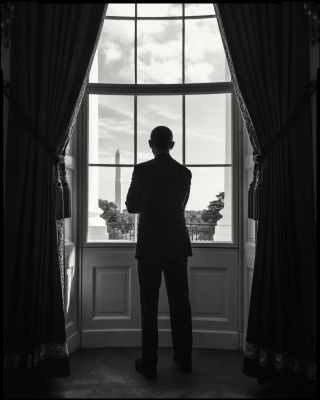Bipolar Disorder
Insights From the Creative Edge of Bipolar Disorder
Photographer Dan Winters maintains his fiery creativity while enjoying wellness.
Posted March 18, 2024 Reviewed by Abigail Fagan

"So, the pictures you make, the ones on fire, they literally are on fire?”
“Oh yeah,” says Dan Winters, photographer and artist whose images you've likely seen capturing key moments in American history.
I met with Winters to understand how, as a person living with bipolar disorder, he harnesses creativity while maintaining balance. “I honestly view my mental health struggles in some ways as having been very beneficial to me in my life because of the hypercreativity, hyperawareness, hyperproductivity—all of those things that go with it.”
There are times, he says, when “colors will seem like they have movement. It’s a real hyperawareness, hyperfocus. It’s almost hallucinatory at times.”
He is not alone. Many have cited the extreme highs and lows of bipolar disorder as providing a window into a different reality and facilitating creativity. Research supports this. A study of 49 people living with bipolar disorder compared with 47 healthy controls found that those diagnosed with the condition scored significantly higher on the Barron-Welsh Art Scale, suggesting an enhanced level of creativity (Santosa et al., 2007).
Additional research has demonstrated that college students who select a major in the arts have a higher lifetime prevalence of bipolar disorder than those in other disciplines (MacCabe et al., 2018). Some investigators have suggested that there may be some overlap in genetic markers of heightened creativity and bipolar disorder.

In the whirlwind of a manic episode, recognizing a need for and accepting help can create a sense of dissonance. The euphoria and energy can be intoxicating. Yet, it is deceptive. Good as the mania feels, it is not joy. It does not often lead someone directly to what matters most to them. Instead, it can trick them and hold them back.
Contrary to the stereotype, for most, bipolar disorder does not present a choice between suffering while being creative and feeling dulled but healthy. Winters emphasizes the importance of support and treatment in his utilizing the best of his abilities. For the last nine years, he says, “I’ve been put on a medication regimen that is a workable one, and I still can operate at a pretty high level of creativity without being in that danger zone.” A positive relationship with a psychiatrist he trusts has been essential in finding the right combination of medications for him.
Research documents the importance of a strong, therapeutic alliance in mental health treatment, yet finding that perfect patient-provider match can be tricky.
Winters knows from experience that someone with bipolar disorder must be proactive in noticing signs of an upcoming mania or depression, and he values the support of his wife in helping him recognize when he is nearing a mood episode. He insists that it's crucial to listen to people around one, as friends and family might notice the symptoms first.
Given the episodic nature of bipolar disorder, there are often times of wellness in addition to major mood episodes. “This isn’t a constant state, in my experience," says Winters. "It comes and goes. You operate on both sides of stable.”
Like many living with the condition, Winters confides, there were times in the past when he would try to keep oncoming manias a secret due to shame and wishing to stay in an up state.
Photography has played a role in Winters’ recovery. Taking a picture can be a way of staying in the moment: “I think photography specifically is a practice that begs for being present. We experience the world fluidly, and the goal of photography is to extract singular moments from that fluidity to create a sort of approximation of what that experience was.” It can be a kind of mindfulness.
.jpg?itok=mHzWgWFL)
Many people living with bipolar disorder benefit from mindfulness practice or creative arts, alongside traditional treatments. A meta-analysis showed that mindfulness-based cognitive therapy led to positive outcomes in mood and anxiety in those with bipolar disorder (Xuan et al., 2020).
Winters' story and insights will be a part of the forthcoming National Geographic documentary Photographer.
References
Greenwood, T. A. (2020). Creativity and bipolar disorder: A shared genetic vulnerability. Annual Review of Clinical Psychology, 16, 239-264.
MacCabe, J. H., Sariaslan, A., Almqvist, C., Lichtenstein, P., Larsson, H., & Kyaga, S. (2018). Artistic creativity and risk for schizophrenia, bipolar disorder and unipolar depression: A Swedish population-based case–control study and sib-pair analysis. The British Journal of Psychiatry, 212(6), 370-376.
Santosa, C. M., Strong, C. M., Nowakowska, C., Wang, P. W., Rennicke, C. M., & Ketter, T. A. (2007). Enhanced creativity in bipolar disorder patients: A controlled study. Journal of affective disorders, 100(1-3), 31-39.
Xuan, R., Li, X., Qiao, Y., Guo, Q., Liu, X., Deng, W., & Zhang, L. (2020). Mindfulness-based cognitive therapy for bipolar disorder: A systematic review and meta-analysis. Psychiatry research, 290, 113116.


